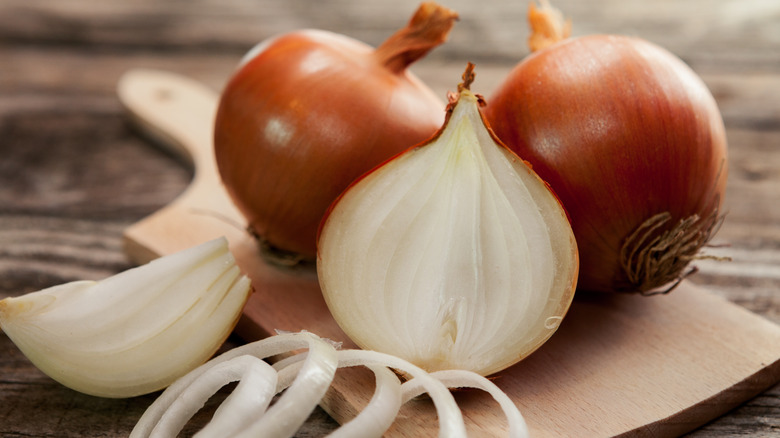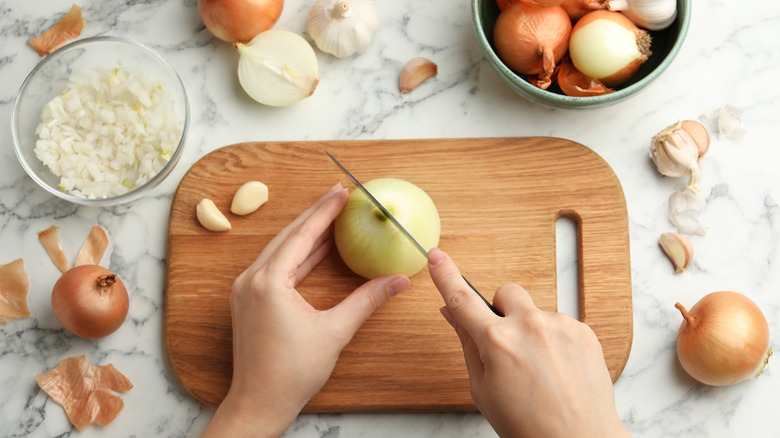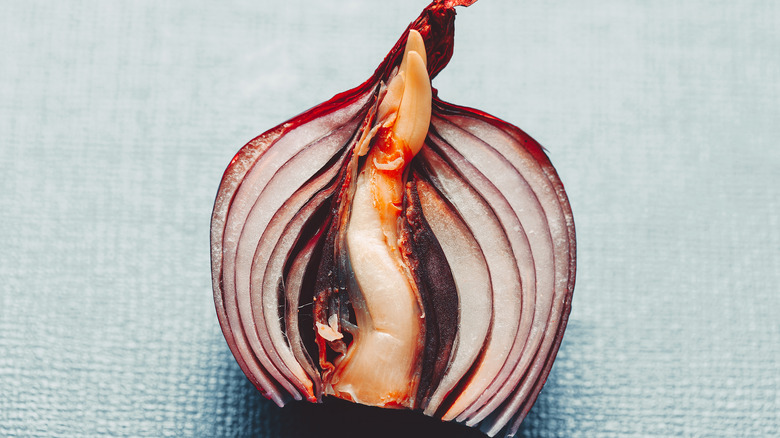The Best Way To Store Half An Onion
Storing half an onion is a peskier matter than one would assume. Firstly, chopped onions have a pungent aroma that can easily transfer to other foods. Even worse, this odor only gets stronger the longer they are stored, eventually emitting a foul stench as they gradually spoil. If you'd rather not have your precious groceries smelling suspiciously like rotten alliums, you'll want to pack that onion in an airtight container or zip-top bag and pop it in the refrigerator.
However, if you plan to reuse the bag or container later, keep in mind that plastic absorbs odors. Anything you store in the vessel afterward will have a sharp onion taste. Instead, switch to a glass container or toss the plastic bag out to avoid making this common food storage mistake. There's also the option of wrapping the half in some cling film, with the sliced side facing down.
No matter which approach you choose, consider leaving the papery outer skin of the onion on. This will serve as a barrier to keep the flesh from drying out, whilst somewhat preventing its aroma from seeping into other foods around it. Stored this way, the allium will stay fresh for five days to a week. Though it might be safe to eat for longer than that, its flavor will deepen into a metallic bitterness. This is why it's best to cook leftover onion halves, instead of trying to use them raw.
You could also freeze the onion half
If a week seems too short for your halved onion, there's always the option of freezing it. In an airtight container, onions will stay fresh for anywhere between three to six months in the freezer, as long as they are kept at zero degrees Fahrenheit. The only catch is that the veggie's texture will soften and break down somewhat once it defrosts, but it's nothing to worry about if you plan to cook it anyway — there will be little change in its actual flavor.
When freezing onion halves, consider chopping them up first. Large chunks of onion will get rock hard in the freezer, meaning you won't be able to cut them unless you wait for them to thaw. That said, it's best to chop them coarsely rather than giving them a fine mince. Onions tend to get soggy in the freezer, so dicing them too finely will turn them into a slush. It's an easily avoidable mistake everyone makes with onions.
It's also a good idea to scoop your chopped onions into smaller, single-serve bags or containers. This allium does not refreeze well, so you risk the entire batch spoiling if you have to thaw and then use the entire thing. Single servings make portioning a snap. Additionally, while frozen onions can be used in any cooked dish, they are not ideal for caramelizing. The process of freezing and thawing adds too much moisture, inhibiting their browning ability.
When to toss out your onion half
Guessing at your onion's freshness can be tricky if you didn't write down the day you stored it on the container. Fresh onions do change in texture and aroma, but that doesn't always mean that they are spoiled. This is why it's important to know exactly what an onion looks, smells, and feels like when it's truly rotten.
The first indicator will be its appearance: Mold is an obvious tell, but also be wary of a chopped or halved onion that is specked with dark or wooly patches, or has begun to sprout. These are generally the first signs of an allium that is about to get moldy, and there are many things that could happen when you accidentally eat mold — none of them good.
If the onion seems fine, but you're still skeptical of its freshness, give it a good whiff. Refrigerated onions may have a more sour and metallic aroma, but they certainly shouldn't smell like compost. Be sure to toss out the onion if it looks or feels slimy as well, or if it disintegrates at the slightest touch. While frozen-and-thawed onions will be soggier than usual, they still shouldn't turn into a puddle under your fingers. On the flip side, don't be afraid of an onion half that looks a touch too dry — simply slice off the withered part and discard it before using up the rest.



